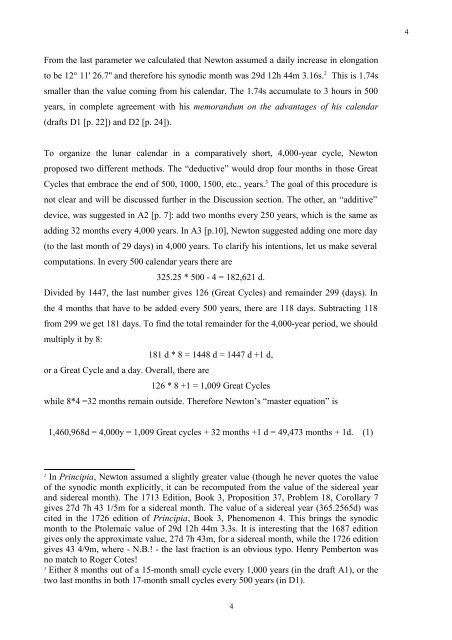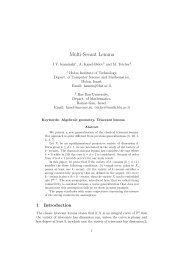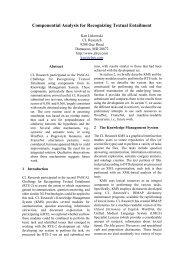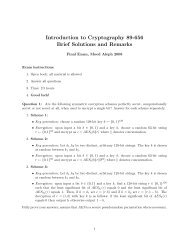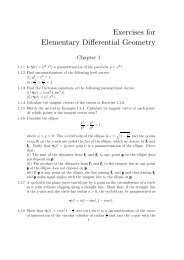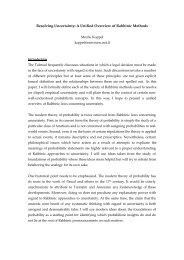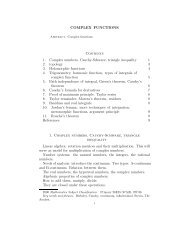Reform of the Julian Calendar as Envisioned by Isaac Newton
Reform of the Julian Calendar as Envisioned by Isaac Newton
Reform of the Julian Calendar as Envisioned by Isaac Newton
You also want an ePaper? Increase the reach of your titles
YUMPU automatically turns print PDFs into web optimized ePapers that Google loves.
4<br />
From <strong>the</strong> l<strong>as</strong>t parameter we calculated that <strong>Newton</strong> <strong>as</strong>sumed a daily incre<strong>as</strong>e in elongation<br />
to be 12° 11' 26.7" and <strong>the</strong>refore his synodic month w<strong>as</strong> 29d 12h 44m 3.16s. 2 This is 1.74s<br />
smaller than <strong>the</strong> value coming from his calendar. The 1.74s accumulate to 3 hours in 500<br />
years, in complete agreement with his memorandum on <strong>the</strong> advantages <strong>of</strong> his calendar<br />
(drafts D1 [p. 22]) and D2 [p. 24]).<br />
To organize <strong>the</strong> lunar calendar in a comparatively short, 4,000-year cycle, <strong>Newton</strong><br />
proposed two different methods. The “deductive” would drop four months in those Great<br />
Cycles that embrace <strong>the</strong> end <strong>of</strong> 500, 1000, 1500, etc., years. 3 The goal <strong>of</strong> this procedure is<br />
not clear and will be discussed fur<strong>the</strong>r in <strong>the</strong> Discussion section. The o<strong>the</strong>r, an “additive”<br />
device, w<strong>as</strong> suggested in A2 [p. 7]: add two months every 250 years, which is <strong>the</strong> same <strong>as</strong><br />
adding 32 months every 4,000 years. In A3 [p.10], <strong>Newton</strong> suggested adding one more day<br />
(to <strong>the</strong> l<strong>as</strong>t month <strong>of</strong> 29 days) in 4,000 years. To clarify his intentions, let us make several<br />
computations. In every 500 calendar years <strong>the</strong>re are<br />
325.25 * 500 - 4 = 182,621 d.<br />
Divided <strong>by</strong> 1447, <strong>the</strong> l<strong>as</strong>t number gives 126 (Great Cycles) and remainder 299 (days). In<br />
<strong>the</strong> 4 months that have to be added every 500 years, <strong>the</strong>re are 118 days. Subtracting 118<br />
from 299 we get 181 days. To find <strong>the</strong> total remainder for <strong>the</strong> 4,000-year period, we should<br />
multiply it <strong>by</strong> 8:<br />
181 d * 8 = 1448 d = 1447 d +1 d,<br />
or a Great Cycle and a day. Overall, <strong>the</strong>re are<br />
126 * 8 +1 = 1,009 Great Cycles<br />
while 8*4 =32 months remain outside. Therefore <strong>Newton</strong>’s “m<strong>as</strong>ter equation” is<br />
1,460,968d = 4,000y = 1,009 Great cycles + 32 months +1 d = 49,473 months + 1d. (1)<br />
2<br />
In Principia, <strong>Newton</strong> <strong>as</strong>sumed a slightly greater value (though he never quotes <strong>the</strong> value<br />
<strong>of</strong> <strong>the</strong> synodic month explicitly, it can be recomputed from <strong>the</strong> value <strong>of</strong> <strong>the</strong> sidereal year<br />
and sidereal month). The 1713 Edition, Book 3, Proposition 37, Problem 18, Corollary 7<br />
gives 27d 7h 43 1/5m for a sidereal month. The value <strong>of</strong> a sidereal year (365.2565d) w<strong>as</strong><br />
cited in <strong>the</strong> 1726 edition <strong>of</strong> Principia, Book 3, Phenomenon 4. This brings <strong>the</strong> synodic<br />
month to <strong>the</strong> Ptolemaic value <strong>of</strong> 29d 12h 44m 3.3s. It is interesting that <strong>the</strong> 1687 edition<br />
gives only <strong>the</strong> approximate value, 27d 7h 43m, for a sidereal month, while <strong>the</strong> 1726 edition<br />
gives 43 4/9m, where - N.B.! - <strong>the</strong> l<strong>as</strong>t fraction is an obvious typo. Henry Pemberton w<strong>as</strong><br />
no match to Roger Cotes!<br />
3<br />
Ei<strong>the</strong>r 8 months out <strong>of</strong> a 15-month small cycle every 1,000 years (in <strong>the</strong> draft A1), or <strong>the</strong><br />
two l<strong>as</strong>t months in both 17-month small cycles every 500 years (in D1).<br />
4


